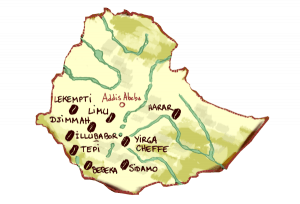With this article we want to begin a fascinating journey of discovery through the coffee producing countries, all located in the so-called “Coffee Belt”, which lies between the Northern and Southern Tropic.
It starts, how could it be otherwise, with the country which is called “The home of the Coffea Arabica”: Ethiopia.
 In Ethiopia, coffee grows in the great outdoors. Originally, coffee from the Kaffa region was exported to Yemen in the 17th century and then spread from there, first in the Middle East and later on, during the colonialism of the Europeans, throughout the world.
In Ethiopia, coffee grows in the great outdoors. Originally, coffee from the Kaffa region was exported to Yemen in the 17th century and then spread from there, first in the Middle East and later on, during the colonialism of the Europeans, throughout the world.
Such a vast of variety of coffee plants can´t be found in any other country in the world. In fact, there are about 1000 different native species, called “heirloom”, which are distributed among the different growing areas:
– Sidamo: from the south of Ethiopia, especially from the regions Yirgacheffe and Guji, comes an excellent coffee, which is characterized by its bitterness. (You can taste this coffee by ordering it as a roasted or green bean, in our range of Caffelab Specialty Coffees).
– Harrar: a very dry, almost desert-like growing area, from which the variety “Ethiopia Harrar” originates, one of the oldest products of the highest aromatic quality.
– Limu and Djimmah: The western part of the country where the coffee is processed according to the “fully washed” method is called Limu. The part in which, it is naturally processed, is called Djimmah.
The immense variety of flavors found in these coffees is largely appreciated by the “Coffee Community”: from a sour, often bergamot-like note (similar to the taste of Earl Gray tea), resembling a sweet and fruit-like taste (apricot, blueberry), to noble the more flowery aromas.
Today, Ethiopia is the 5th largest coffee producer in the world, covering 5% of the world’s coffee production. In the country itself, drinking coffee is one of the true traditions.

